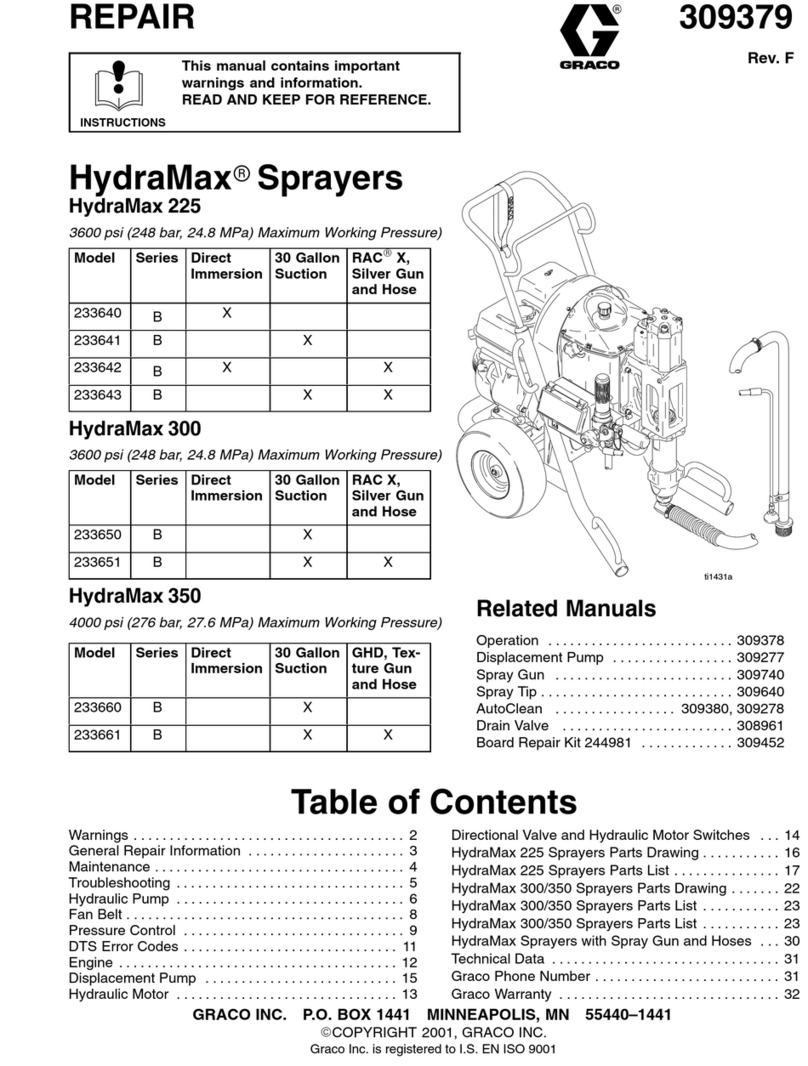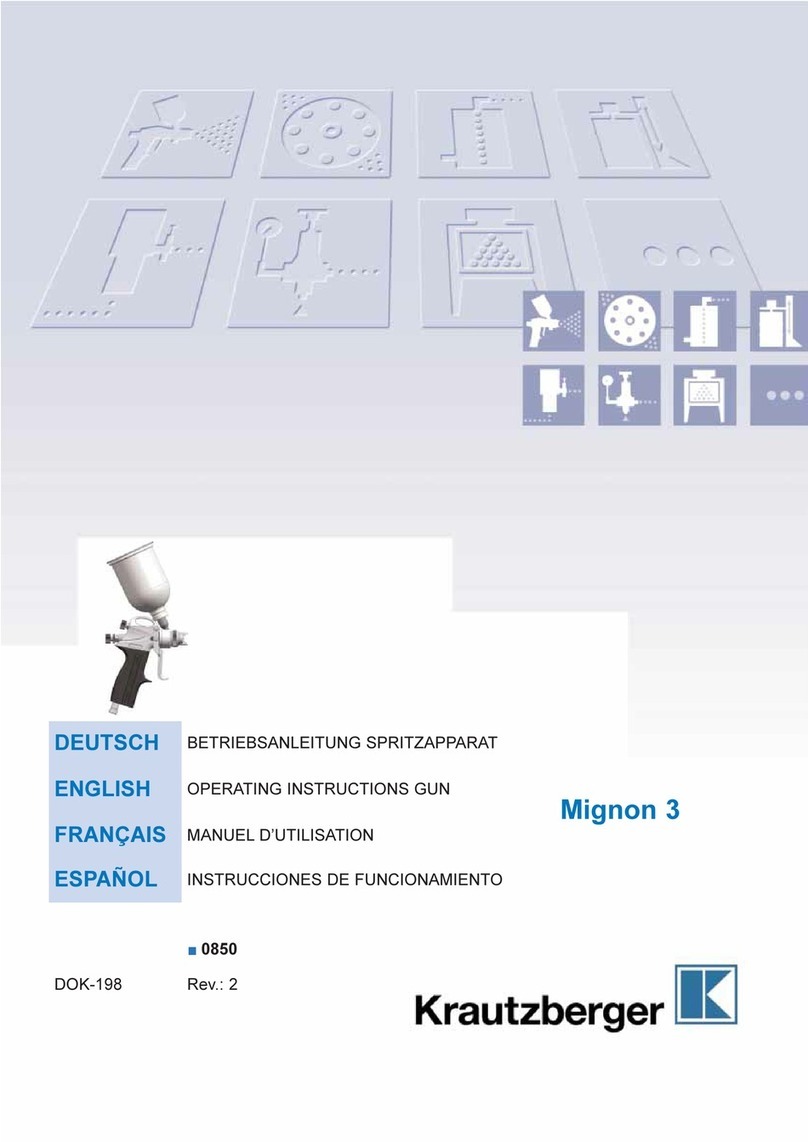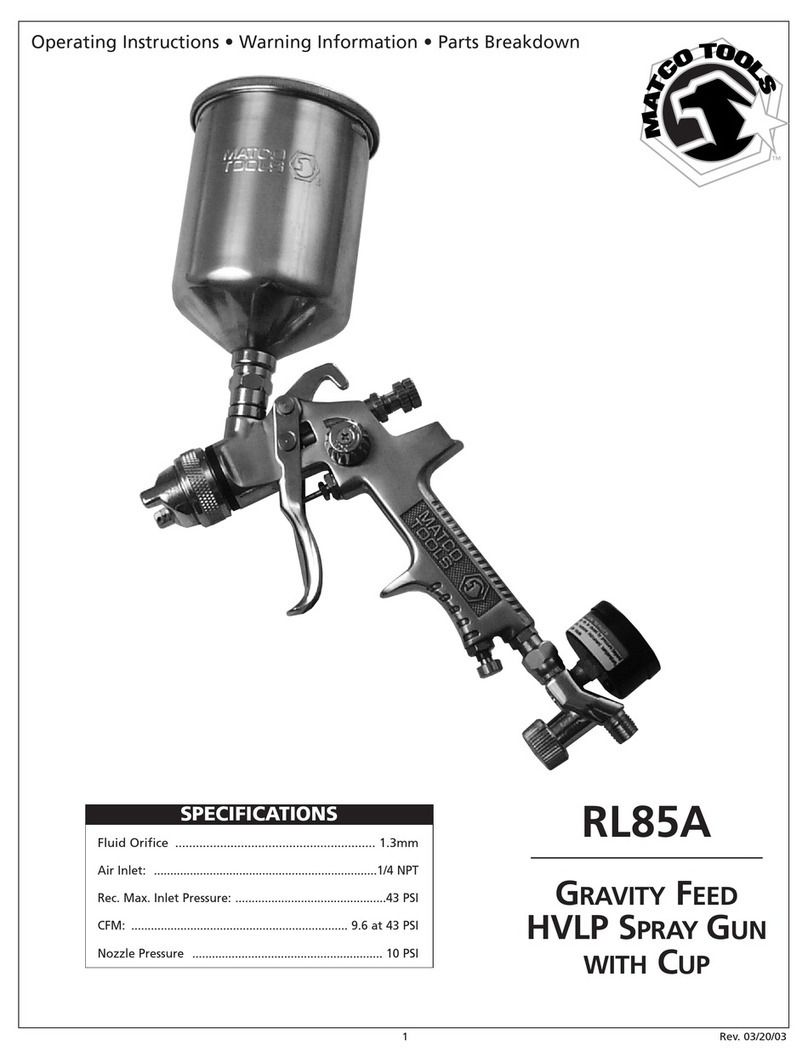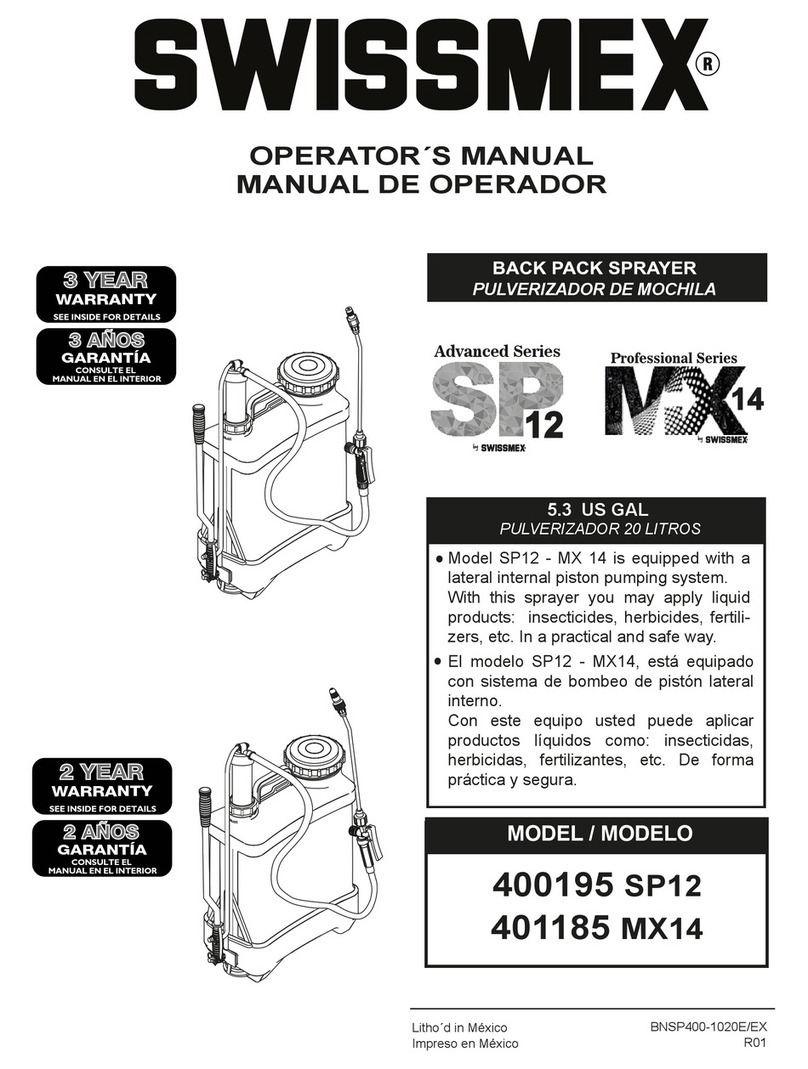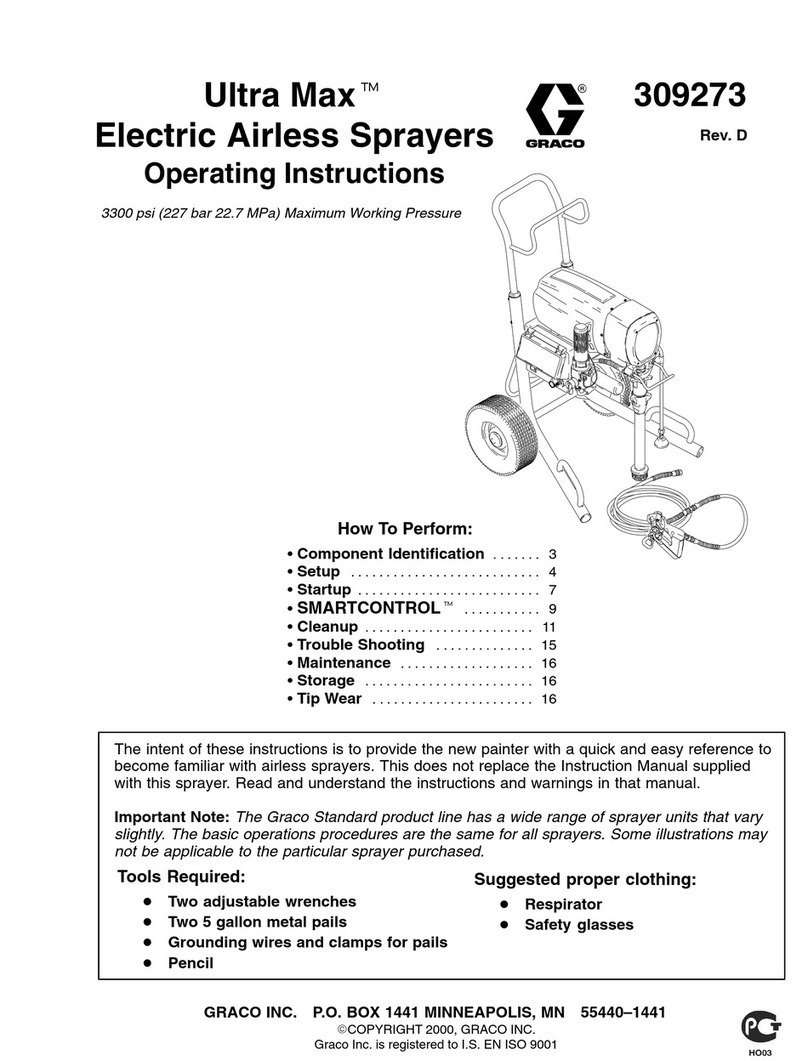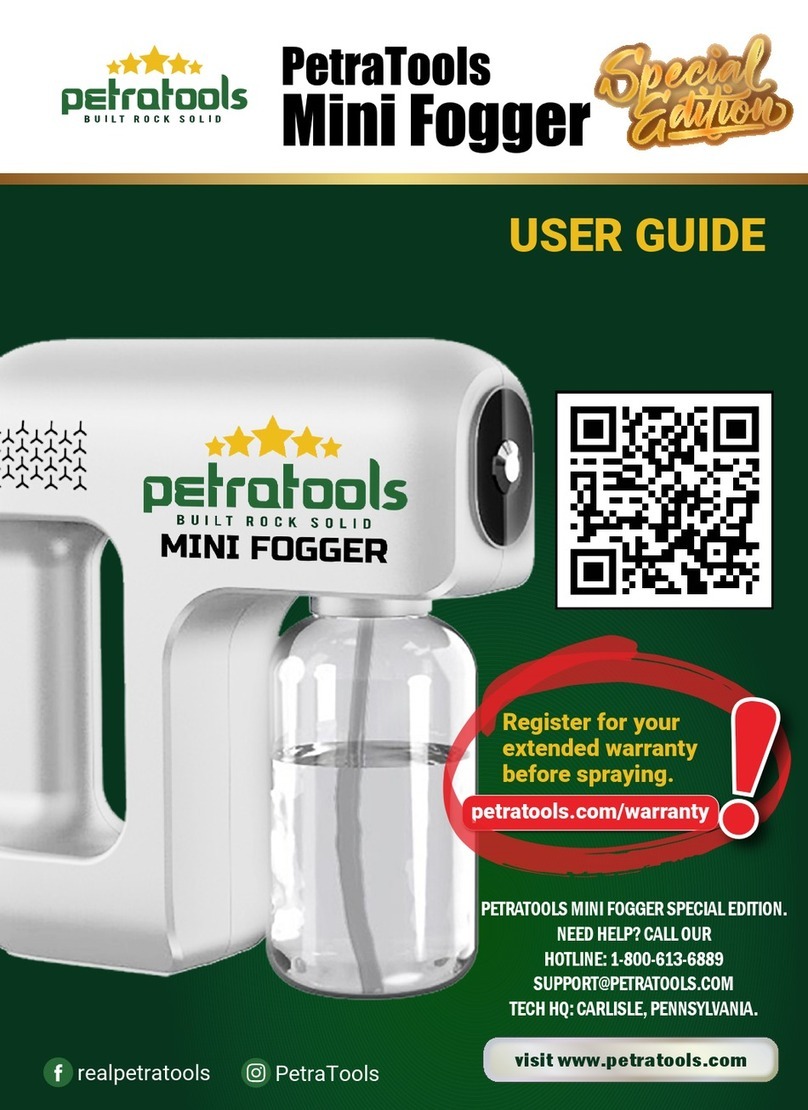SIEGEN S775 User manual

The S775 is a well balanced spray gun which is suitable for primer and undercoat. Supplied with an
aluminium suction feed pot, the gun has the following specification:
Instructions for:
SUCTION FEED SPRAY GUN
Model: S775
Thank you for purchasing a Siegen product. Manufactured to a high standard this product will, if used according to these instructions and
properly maintained, give you years of trouble free performance.
Standard Set-up: . . . . . . . . . . . . . . . . . . . . . . . . . . . . . . . .Ø1.8mm
Operating Air Pressure: . . . . . . . . . . . . . . .3.5 - 4.5 bar (50 - 65psi)
Air Consumption: . . . . . . . . . . . . . . . . . . . . . . . . . . . . .12 - 15cfm
Pot Capacity . . . . . . . . . . . . . . . . . . . . . . . . . . . . . . . . . . . . .1 litre
Air Connection . . . . . . . . . . . . . . . . . . . . . . . . . . . . . . . . .1/4"BSP
2. SPECIFICATION
IMPORTANT: PLEASE READ THESE INSTRUCTIONS CAREFULLY. NOTE THE SAFE OPERATIONAL REQUIREMENTS,
WARNINGS AND CAUTIONS. USE THE PRODUCT CORRECTLY AND WITH CARE FOR THE PURPOSE FOR WHICH IT IS
INTENDED. FAILURE TO DO SO MAY CAUSE DAMAGE AND/OR PERSONAL INJURY AND WILL INVALIDATE THE
WARRANTY. PLEASE KEEP INSTRUCTIONS SAFE FOR FUTURE USE.
1. SAFETY INSTRUCTIONS
!Familiarise yourself with the application and limitations, as well as the potential hazards of the spray gun.
"WARNING! Disconnect the spray gun from the air supply before changing accessories, servicing or performing any maintenance.
!Maintain the spray gun in good condition (use an authorised service agent).
!Replace or repair damaged parts. Use recommended parts only. Unauthorised parts may be dangerous and will invalidate the warranty.
!Locate the spray gun in a suitable work area, keep area clean and tidy and free from unrelated materials, and ensure that there is adequate
ventilation and lighting.
!Keep the spray gun clean for best and safest performance.
!Ensure that the air system has sufficient output for the spray gun air consumption (see specification).
!Wear approved respiratory protection, safety eye goggles and skin protection.
!Remove ill fitting clothing. Remove ties, watches, rings and other loose jewellery and tie back long hair.
!Keep children and unauthorised persons away from the work area.
!When gun is not in use ensure that the air supply is disconnected.
!Avoid unintentional operation.
#DO NOT paint were there is any source, or possible source, of ignition as paint mist is extremely flammable.
#DO NOT point spray gun at yourself or at other persons or animals.
#DO NOT carry the gun by the air hose, or yank the hose from the air supply.
#DO NOT use the spray gun for any purpose other than that for which it is designed.
#DO NOT allow untrained persons to operate the spray gun.
#DO NOT get the spray gun wet or use in damp or wet locations or areas where there is condensation.
#DO NOT operate gun if any parts are missing or damaged as this may cause failure and/or personal injury.
#DO NOT direct air from the air hose at yourself or others.
!When not in use switch off the air supply and disconnect the spray gun.
3. AIR SUPPLY
4. PREPARATION
3.1. Ensure that the air valve is in the "off" position before connecting to the air supply.
3.2. You will require an air pressure of approximately 60psi and an air volume of more than 12cfm to operate the gun.
"WARNING! Ensure the air supply is clean does not exceed 90psi. Too high an air pressure and unclean air will shorten the
life of the gun due to excessive wear and may be dangerous, causing damage and/or personal injury.
3.3. Drain the air supply tank daily. Water in the air line will damage the gun and contaminate the paint.
3.4. Clean the compressor air inlet filter weekly. For recommended hook-up, see diagram.
3.5. Line pressure should be increased to compensate for unusually
long air hoses (over 8 metres). The minimum hose bore
should be 10mm and fittings must have the same
inside dimensions.
3.6. Keep hose away from heat, oil and sharp
edges. Check hoses for wear, and make
certain that all connections are secure.
The gun was treated with an anti-corrosion agent to protect it prior to first use. Before first use make sure that the gun is flushed with paint
solvent to remove the agent.
"WARNING! Solvents and cleaning agents based on halogenated hydrocarbons, e.g. 1.1.1-trichlorethylene and methylene chloride, may have
a chemical reaction with the aluminium components of the gun. In extreme cases the reaction can be explosive. Therefore, use only
solvents/cleaning agents which DO NOT contain these substances.
S775 - 1 - 030702
Siegen

IT IS VERY IMPORTANT TO ENSURE THAT THE GUN IS CORRECTLY CLEANED AFTER EACH USE.
Disconnect from the air supply before attempting any cleaning, other than flushing, or maintenance.
6.1. Cleaning the gun
6.1.1. Flush the gun thoroughly with solvent and clean the nozzle with solvent and a brush. DO NOT immerse/soak the nozzle in solvent.
6.1.2. DO NOT immerse the entire gun in solvent. This will cause lubricants to dissolve and packing to dissolve or dry out.
6.1.3. Wipe the outside of the gun with a solvent-dampened rag.
6.1.4. If you need to clear blocked orifices, be sure to use a probe that is softer than brass.
6.2. Maintenance
Take care when re-assembling. Screw parts hand tight to avoid cross-threading. If a part cannot easily be turned by hand, check that
you have the correct part, or unscrew, realign and try again. DO NOT use excessive force when re-assembling.
6.2.1. Lubricate the gun daily with a light machine oil. Be sure to lubricate the fluid needle packing, air valve packing and trigger pivot point.
6.2.2. If you change the nozzle size, ensure the complete nozzle set is exchanged. Insert paint nozzle before putting the paint needle in.
6. CLEANING & MAINTENANCE
5. OPERATING INSTRUCTIONS
Ensure that you have read and understood the safety instructions in Section 1 and the warning in Section 4.
5.1. For best results the gun must be handled and operated correctly. It should be held perpendicular to the surface being sprayed and
moved parallel to it. Start the stroke before squeezing the trigger and release the trigger before finishing the stroke. This will enable you
to accurately control the gun and paint (fig. 1).
5.2. Spray from a distance of about 6 to 10 inches depending on the material and the atomizing pressure. The paint deposited should always
be even and wet. Each stroke must overlap the preceding stroke to obtain a uniform finish. To reduce over-spray and obtain maximum
efficiency, spray with the lowest effective atomizing air pressure.
5.3. Controlling the fan spray and the paint:
a) Use the paint control knob (fig. 2.B) to increase or decrease the paint flow.
b) Fig. 2.C is the air input control and should be set to the lowest effective flow.
c) Turn the air cap (fig. 3.1) to achieve a horizontal or vertical fan spray. Lock the cap with retaining ring (fig. 3.2).
d) The spray pattern is variable from round to flat with all patterns in between, controlled by the pattern knob (fig.2.A).
e) In normal operation, the wings on the cap are horizontal as fig. 3. This provides a vertical fan-shaped pattern (fig. 4) which gives
optimum coverage when moving the gun back and forth, parallel to the work surface.
fig. 1
fig. 2
fig. 3
fig. 4
S775 - 1 - 030702
7. TROUBLESHOOTING
Dried material in a dirty side port restricts passage of air.
Greater flow of air from the cleaner side port forces the fan
pattern in the direction of the clogged side.
Dried material around the outside of the fluid nozzle tip restricts
the passage of atomizing air at one point through the centre
opening of the air cup and results in the pattern shown. This
pattern can also be caused by a loose air cup.
A split spray or one that is heavy at each end of the fan pattern
and weak in the middle is usually caused by too high an
atomization air pressure or by attempting to get too wide a spray
with thin paint.
1. Worn needle packing permits air to get into the fluid
passageway. This results in spitting.
2. Dirt between the paint nozzle seat and body or a loose
paint nozzle will cause the gun to spit.
3. A loose or defective joint between the pot and gun can
cause spitting.
Dissolve material in the side ports with solvent, then blow the gun clean.
Do not poke the orifice with a metal instrument.
Remove the air cup and wipe off fluid tip using a rag dampened with
solvent. Tighten the air cup.
Dried material in a dirty side port restricts passage of air. Greater flow of
air from the cleaner side port forces a fan pattern in the direction of the
clogged side.
1. Tighten the packing screw or, in severe cases, replace the packing.
2. Remove the fluid nozzle, clean the back of the nozzle and the nozzle
seat in the gun body using a rag dampened with solvent.
3. Tighten or replace.
VIEW OF PROBLEM POSSIBLE REASON FOR PROBLEM SOLUTION
A faulty spray is usually caused by improper cleaning or dried material around the fluid nozzle tip or in the air cup - use a brush and solvent to
remove. Never use metal instruments to clean the air cup or paint nozzle. These parts are carefully machined and any damage to them will
cause a faulty spray. If either the air cup or paint nozzle is damaged, the part must be replaced before a perfect spay can be obtained.
Table of contents
Other SIEGEN Paint Sprayer manuals
Popular Paint Sprayer manuals by other brands
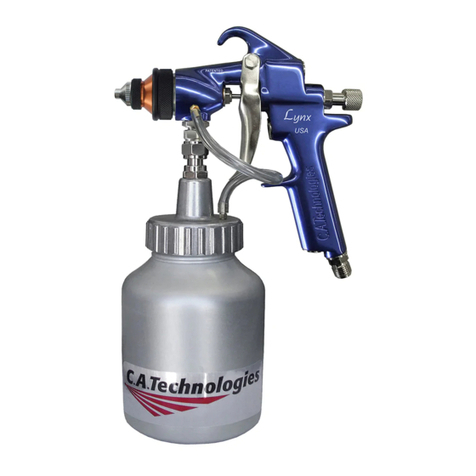
C.A. Technologies
C.A. Technologies Lynx 100CM Product information
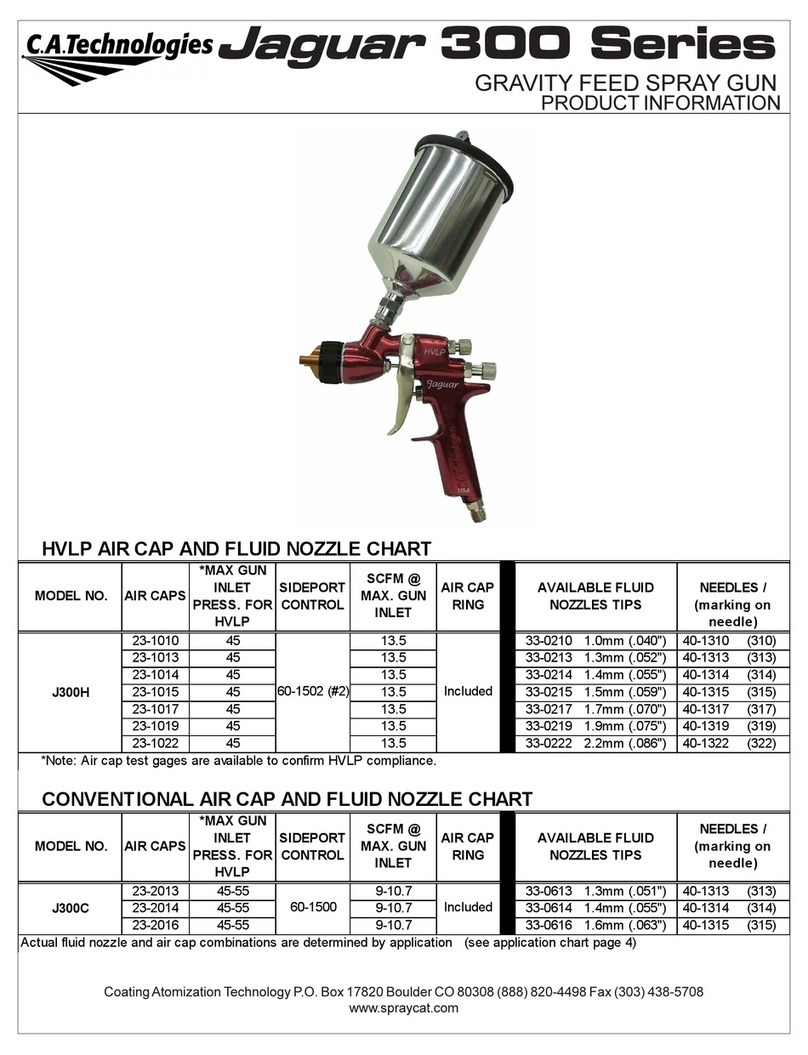
C.A. Technologies
C.A. Technologies Jaguar 300 Series Product information
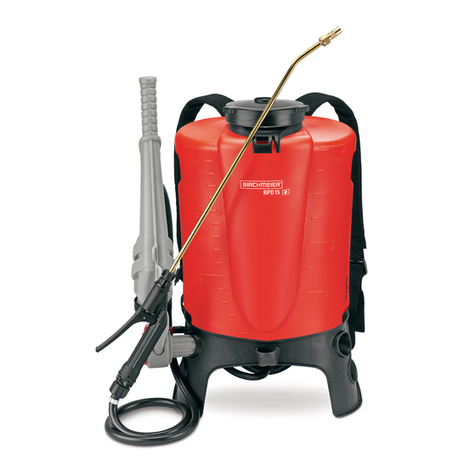
Birchmeier
Birchmeier RPD 15 ATS Instructions for use
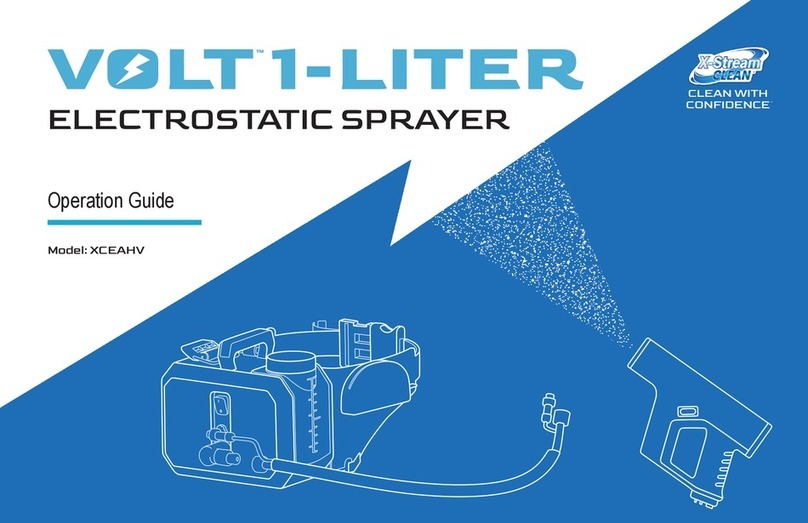
X-Stream CLEAN
X-Stream CLEAN Volt XCMADD Operation guide
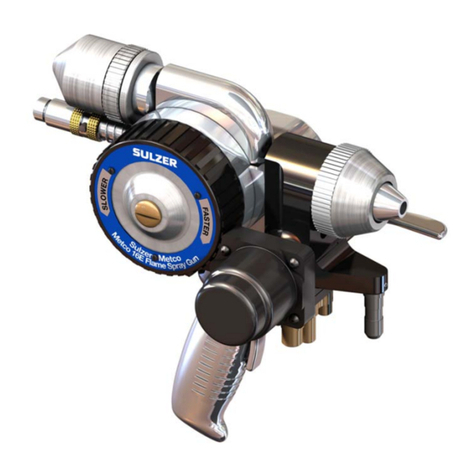
Sulzer
Sulzer 16E product manual

Smithco
Smithco 300G282 Parts & Service



